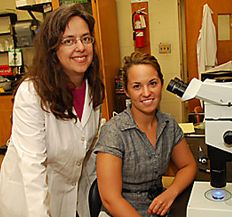非常抱歉,
你要访问的页面不存在,
非常抱歉,
你要访问的页面不存在,
非常抱歉,
你要访问的页面不存在,
验证码:

职称:Associate Professor
所属学校:Catholic University of America
所属院系:Biology
所属专业:Biology/Biological Sciences, General
联系方式: 202-319-5274
B.S., Biology, Cornell University, Ithaca, New York Ph.D., Molecular and Cell Biology, University of California, Berkeley. Postdoctoral Research, Muscle Development, National Institutes of Health.
Our research is aimed at understanding the basic question in developmental biology: "During development, how does a cell's fate become specified?" Or, more simply, how does a cell know to become a muscle cell and not a nerve cell or some other type of cell? Specific proteins contribute to a cell's fate, and regulators called transcription factors control the presence of these proteins. A careful examination of how transcription factors perform their function, therefore, will be critical for understanding cell-fate specification. We are studying cell-fate specification in the context of transcriptional regulation in the mesoderm. The mesoderm is the middle embryonic germ layer from which muscle, connective, and heart tissues are derived. The model organism that we use is the nonparasitic soil nematode, Caenorhabditis elegans. C. elegans have a number of advantages for studying development such as transparent cells, complete genome information, and powerful genetics. The animals also have a short generation time of 3 days allowing rapid experimentation. In addition, the nematodes have several tissue types that are mesodermal in origin and yet a small total number of mesodermal cells so that we can focus on events at a single cell level. A number of transcription factors play a role in cell-fate specification. We are focusing on a basic helix-loop-helix (bHLH) transcription factor CeTwist, which plays a role in patterning and specification of the mesoderm in C. elegans. Our aim is to understand the mechanism by which this factor controls the expression of target genes in a diverse set of mesodermal cells. CeTwist forms heterodimers with another bHLH factor, CeE/DA. As first step towards our aim, we have identified target genes of the heterodimers using microarrays representing all of the transcripts in the C. elegans genome (Wang et al., 2006). We have also explored the mechanism of regulation of one of the target genes, arg-1 (Zhao et al., 2007). In the promoter region of arg-1, we have found three elements that are uniquely required for the expression pattern of arg-1. Currently, we are pursuing various lines of investigation to understand how these elements are uniquely used by the bHLH factors for regulating transcription in individual cells. Furthermore, we have identified a role for CeTwist containing homodimers (manuscript in preparation) and are using a microarray approach to identify target genes of the homodimers. Finally, in order to understand the temporal and spatial regulation of the CeTwist and CeE/DA genes, we are using a reporter gene approach to identify elements important for their expression. Collectively, we expect our multifaceted approaches will provide a mechanistic understanding of target gene control by bHLH factors in mesoderm development.